You'll find epoxy flooring stands as the top choice for cleanroom environments due to its superior chemical resistance, seamless application, and exceptional durability. Vinyl solutions offer excellent cleanability and chemical resistance, making them ideal for pharmaceutical ISO-5 cleanrooms, while raised access floor systems optimize airflow and utility management. For maximum protection, consider combination coatings that blend epoxy and polyurethane. Your selection should align with your specific ISO classification requirements and operational needs, focusing on static control, particle containment, and maintenance demands. The right flooring choice will dramatically impact your cleanroom's long-term performance and compliance standards.
Understanding Static Control Requirements
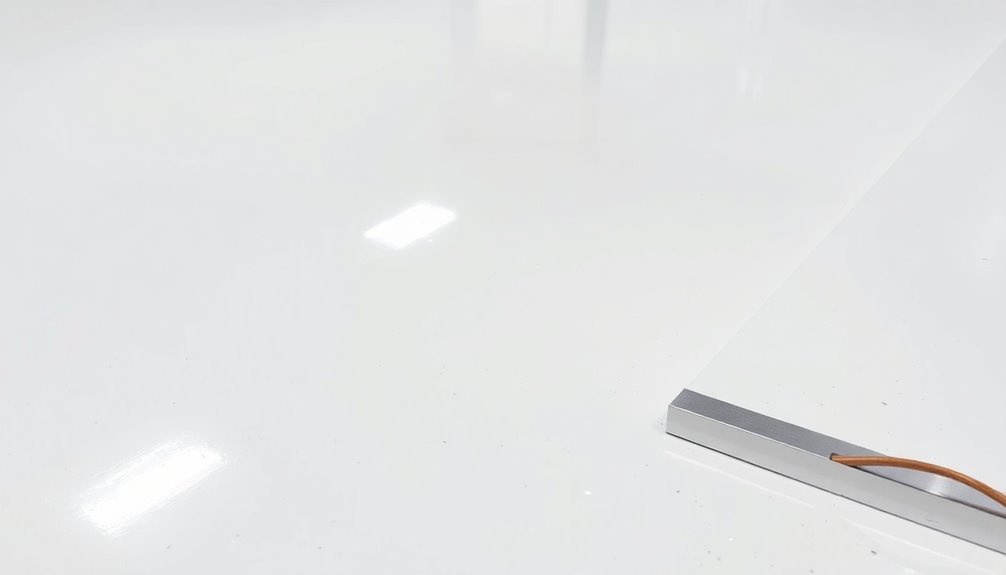
In today's sensitive manufacturing environments, static control plays a vital role in protecting equipment and products from damage. You'll need to understand that static charges can accumulate on surfaces, equipment, and personnel, potentially causing device malfunctions, electric shocks, and costly equipment damage if not properly managed.
To effectively control static in your cleanroom, you'll want to focus on three primary methods: conduction, dissipation, and neutralization. Your flooring choice will serve as a significant component of your static control strategy, working alongside other measures like anti-static wall panels and proper personnel equipment. Regular assessments of your static control measures help ensure their continued effectiveness.
You'll need to select materials with low resistance to electron flow, ensuring charges are safely guided to the ground.
When evaluating your static control requirements, you must consider industry standards and specifications that govern ESD protection. Your flooring system should align with these standards while meeting your specific needs for electrical performance and cleanliness.
Remember that static control isn't just about the floor – it's part of a thorough approach that includes proper clothing, equipment, and continuous monitoring to maintain a controlled environment that protects your sensitive operations.
Cleanroom Classification and Flooring Selection
Selecting appropriate flooring for your cleanroom begins with understanding classification standards and cleanliness requirements. The ISO 14644-1 classification system, which ranges from ISO 1 to ISO 9, determines the acceptable particle count limits for your controlled environment. For instance, if you're operating an ISO 5 (Grade A) cleanroom, you'll need flooring that can maintain a particle count of no more than 3,520 particles ≥ 0.5 µm per cubic meter.
Your flooring choice should align with both your cleanroom classification and operational needs. The selection process should account for air changes per hour requirements specific to each ISO class level. Here's what you'll need to take into account:
- For ISO 5-6 environments, you'll want seamless options like epoxy or vinyl flooring that prevent particle accumulation and offer superior cleanability.
- ISO 7-8 cleanrooms can utilize industrial VCT tiles or polished concrete, providing a balance between cleanliness and cost-effectiveness.
- Class 100 semiconductor facilities often require raised flooring systems for ideal air flow management.
- All flooring selections must account for chemical resistance, durability, and static control requirements specific to your industry.
Remember that your flooring choice isn't just about meeting classification standards – it must also withstand your facility's specific cleaning protocols, foot traffic patterns, and equipment loads.
Epoxy Coating Benefits
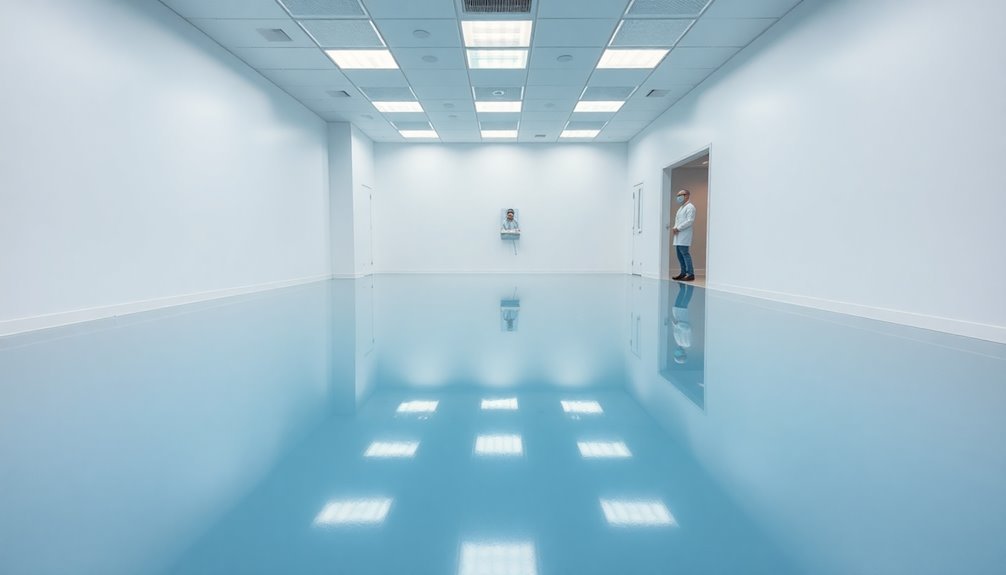
You'll find epoxy coatings excel in cleanroom environments due to their superior resistance against harsh chemicals and cleaning agents.
The coating's remarkable durability withstands constant foot traffic and heavy equipment movement without showing signs of wear or deterioration. A typical system includes epoxy primer and finish to ensure optimal performance.
When you factor in the minimal maintenance requirements and extended lifespan, epoxy coatings provide significant cost savings compared to traditional flooring options.
Superior Chemical Resistance
Through years of rigorous testing, epoxy coatings have proven their exceptional resistance against a wide array of harsh chemicals, including aluminum hydroxide, potassium hydroxide, and potassium permanganate. After seven days of immersion, controlled studies showed absolutely no degradation of the epoxy surface.
You'll find that these surfaces show no signs of erosion or pitting, even when exposed to powerful detergents and disinfectants commonly used in cleanroom environments.
The superior chemical resistance of epoxy flooring makes it an ideal choice for laboratories and pharmaceutical facilities, where maintaining sterility and safety is paramount.
Here's why epoxy's chemical resistance stands out:
- You won't need to worry about chemical spills damaging the surface, as epoxy outperforms other materials like vinyl in out-gassing tests.
- You'll benefit from the non-porous nature of epoxy, which prevents chemicals from penetrating and compromising the floor's integrity.
- You can safely use eco-friendly cleaners without fear of degrading the surface.
- You'll reduce maintenance costs since the chemical-resistant properties prevent the need for frequent repairs or replacements.
This remarkable chemical resistance, combined with epoxy's seamless application, guarantees your cleanroom floor maintains its protective properties while supporting a sterile environment.
Durability Under Heavy Traffic
Standing up to constant foot traffic and heavy equipment movement, epoxy coatings deliver exceptional durability that surpasses traditional flooring materials. You'll find that epoxy's seamless surface minimizes weak points where cracks might develop, while its dense, low-porosity structure guarantees lasting resilience against daily wear and tear.
What makes epoxy particularly suitable for high-traffic cleanroom environments is its ability to maintain structural integrity under demanding conditions. You won't need to worry about heavy equipment damaging the surface, as epoxy coatings can withstand substantial weights without showing signs of deterioration. The combination of resins and hardening compounds creates a robust surface that effectively restores and protects worn concrete floors underneath.
| Feature | Benefit |
|---|---|
| Seamless Surface | Prevents contaminant accumulation |
| Low Porosity | Enhances durability and cleanability |
| Impact Resistance | Protects against equipment damage |
The versatility of epoxy flooring extends beyond its durability. You can customize the surface with various colors and textures to meet your specific requirements, including anti-slip properties for enhanced safety. When you factor in its abrasion-resistant qualities and ability to maintain its appearance under heavy use, epoxy flooring proves to be an ideal choice for cleanroom environments where reliability and longevity are paramount.
Long-Term Cost Savings
While epoxy flooring's durability makes it an attractive choice, its financial benefits create an even more compelling case for cleanroom applications. You'll find that the higher initial investment quickly pays off through reduced maintenance costs, fewer repairs, and extended lifespan. The seamless surface doesn't just meet cleanroom standards – it actively contributes to your bottom line by minimizing the time and resources needed for cleaning and maintenance.
Your long-term cost savings will come from multiple sources:
- Reduced maintenance expenses through chemical resistance and easy-to-clean surfaces that don't harbor contaminants
- Minimal operational disruptions due to fewer repairs and replacements, keeping your cleanroom productive
- Lower labor costs from simplified cleaning procedures and decreased maintenance requirements
- Extended material life that eliminates frequent replacement needs, spreading your initial investment over many years
When you're considering sustainable options, epoxy flooring aligns with both environmental and financial goals. The eco-friendly materials and low-emission properties contribute to compliance while reducing long-term costs. With 46.3% market share projected for epoxy flooring, it's clear that industry professionals recognize its superior value proposition.
You'll also benefit from improved operational efficiency as your staff can maintain the flooring with minimal effort, allowing them to focus on core cleanroom activities.
Rubber Sheet Installation Methods
For successful rubber sheet installation in cleanrooms, proper preparation and technique are essential to maintain the environment's strict cleanliness standards. Professional installation is recommended since static control performance depends heavily on proper installation methods.
You'll need to start by verifying your subfloor is clean, dry, and free of debris. Before installation, you must unroll the rubber sheets and let them relax for at least 12 hours.
When you're ready to install, apply the manufacturer-recommended adhesive after conducting a bond test. You'll lay the first roll carefully, as it sets the foundation for the entire installation. Each subsequent sheet should overlap the previous one by 1/2 inch to verify proper seam alignment.
After waiting 24 hours, you'll need to heat weld all seams using specific weld rods and skiving techniques.
For cleanroom environments, you'll want to use conductive rubber flooring with fast-drying, pressure-sensitive adhesives that won't disrupt operations. The installation must meet Class-0 Qualification standards for ultra-sensitive component handling.
Once installed, you'll need to perform regular ESD audits and maintenance to verify the flooring continues to meet stringent cleanliness and static control requirements.
Vinyl Solutions for Cleanrooms
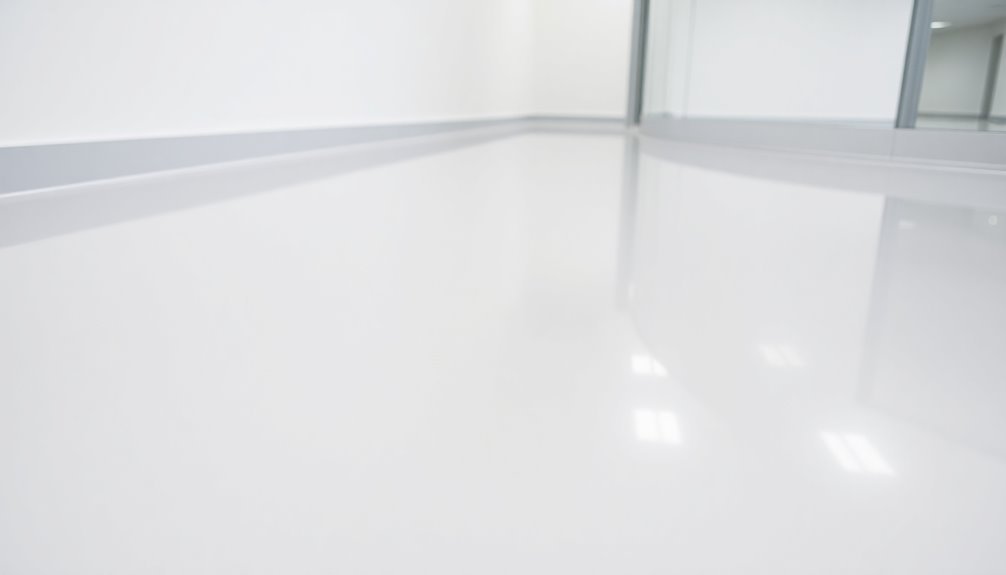
Choosing the right vinyl solution for your cleanroom environment requires careful evaluation of specific operational needs and cleanliness requirements.
When you're assessing vinyl options, you'll find that each type serves distinct purposes, from seamless flooring ideal for small cleanrooms to heat-welded systems perfect for pharmaceutical applications. VCT installations require proper sealant application to prevent contamination and maintain cleanliness standards.
1. Vinyl seamless flooring offers excellent cleanability and cost-effectiveness for small facilities, though it won't hold up well under heavy traffic.
You'll need to take into account its temperature sensitivity when planning your installation.
2. VCT provides a budget-friendly solution for Class 7 & 8 electronics cleanrooms and comes in ESD configurations.
While it's durable and economical, you'll face higher maintenance demands due to numerous seam joints.
3. Heat-welded vinyl flooring stands out for pharmaceutical ISO-5 cleanrooms, offering superior chemical resistance and integral cove protection.
It's particularly effective in semiconductor environments where temperature uniformity is essential.
4. When selecting vinyl flooring, you'll need to assess UV stability and chemical compatibility for your specific application.
If you're in electronics manufacturing, think about ESD configurations, while pharmaceutical applications will require heat-welded options for best performance.
Raised Access Floor Systems
Raised access floor systems revolutionize cleanroom environments by creating an elevated platform above the building's base floor. You'll find these systems particularly valuable for optimizing airflow control and temperature management while eliminating condensation issues that typically plague overhead HVAC systems.
When you install a raised access floor, you're gaining significant space efficiency advantages. The system lets you house bulky utilities beneath the floor, freeing up valuable workspace above while maintaining easy access for maintenance through movable panels. You won't need costly expansions since you're maximizing your existing space.
You'll appreciate the remarkable flexibility these systems offer. Whether you're reconfiguring your cleanroom layout or modifying utility arrangements, you can make changes without disrupting your core infrastructure. This adaptability proves essential in dynamic cleanroom environments where layout modifications are frequent.
The system's utility management capabilities are equally impressive. You'll achieve a cleaner, safer environment by concealing cables and electrical components beneath the floor.
Remember to select panels that meet specific load-bearing requirements and possess essential characteristics like wear resistance, moisture resistance, and flame retardancy. Your installation must comply with strict tolerance specifications to guarantee stability and safety.
Chemical Resistance Comparison
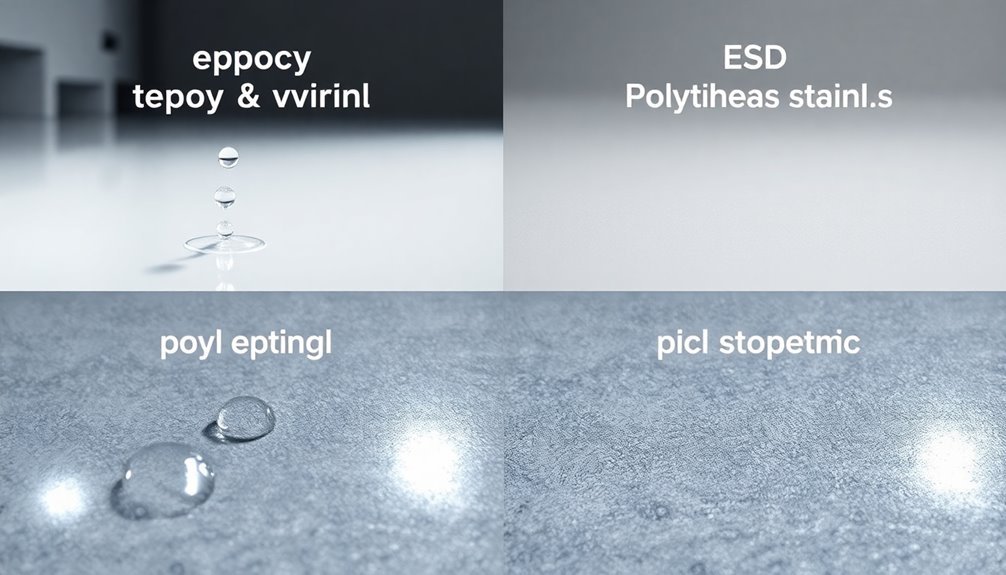
Three primary flooring materials dominate cleanroom environments when chemical resistance is essential: epoxy, polyurethane, and vinyl. When you're selecting a flooring material based on chemical resistance, you'll need to assess your specific needs against each option's capabilities.
1. Epoxy flooring offers exceptional resistance to acids, solvents, and detergents, making it ideal for pharmaceutical and electronics cleanrooms.
You'll find its seamless finish particularly beneficial in preventing contamination buildup, while its durability withstands heavy machinery and constant foot traffic.
2. Polyurethane stands out with its superior resistance to organic acids and NMP solvents, vital for EV battery manufacturing.
You'll appreciate its unique flexibility that handles thermal shock and temperature variations better than other options.
3. Vinyl provides moderate chemical resistance, suitable for cleanrooms with minimal exposure to harsh chemicals.
While it's easy to maintain, you'll need to take into account its limitations with heavy machinery and solvent exposure.
4. When maximum protection is needed, you can opt for combination coatings that blend epoxy and polyurethane properties.
These tailored solutions guarantee thorough chemical resistance while meeting your specific cleanroom requirements.
Cost Analysis of Materials
While chemical resistance plays a key role in material selection, the financial aspects of cleanroom flooring demand careful consideration. You'll find that high-performance materials like epoxy and polyurethane typically cost between $10-20 per square foot, with ESD-compliant options commanding even higher prices due to their specialized properties.
When you're planning your cleanroom flooring project, you'll need to factor in both material and installation costs. The installation process requires specialized labor, equipment, and precise application techniques, particularly for ESD flooring. Your cleanroom's classification, size, and specific requirements will notably impact the overall cost structure.
While the initial investment might seem steep, you'll discover long-term cost benefits that justify the expense. High-quality materials reduce maintenance needs, extend lifespan, and minimize contamination risks.
You can also consider sustainable options like recycled vinyl or bio-based polyurethanes, which may cost more upfront but offer savings through reduced energy consumption and maintenance requirements. Additionally, these materials can improve indoor air quality and worker productivity by eliminating VOCs, potentially leading to reduced healthcare costs and increased operational efficiency.
Maintenance Best Practices
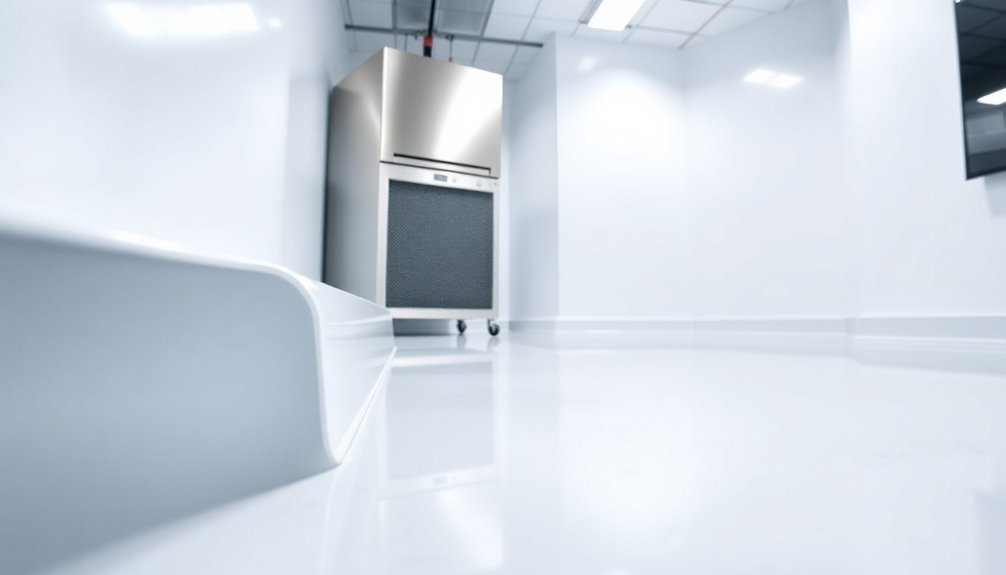
Maintaining cleanroom flooring requires a systematic approach to preserve its integrity and performance.
You'll need to implement rigorous cleaning protocols that include daily inspections, proper mopping techniques, and regular monitoring of surface conditions. It's essential to use only cleanroom-approved cleaning solutions and non-shedding materials to prevent contamination.
To guarantee peak maintenance of your cleanroom flooring, follow these essential practices:
- Establish a structured cleaning schedule that includes daily dry and wet mopping, moving from the cleanest areas to the dirtiest to prevent cross-contamination.
- Monitor and document environmental conditions daily, including particle counts, differential pressure, and temperature/humidity levels.
- Conduct regular surface inspections using linear wiping techniques and approved disinfectants to maintain sterile conditions.
- Perform periodic audits and compliance checks to verify cleaning effectiveness and address any maintenance issues promptly.
You'll want to maintain detailed records of all cleaning activities and inspections for compliance purposes.
Regular training of maintenance personnel guarantees they're following the latest protocols and best practices.
Remember to replace cleaning materials frequently and inspect them before each use to prevent introducing new contaminants into your controlled environment.
Future of Cleanroom Flooring
You'll see major breakthroughs in cleanroom flooring through smart self-cleaning surfaces that automatically detect and eliminate contaminants.
New sustainable materials, including bio-based polyurethanes and recycled composites, will transform the industry while meeting strict cleanroom requirements.
IoT sensors embedded in floors will provide real-time monitoring of contamination levels, foot traffic patterns, and maintenance needs, helping you optimize cleanroom operations.
Smart Self-Cleaning Surfaces
Leading the next wave of cleanroom innovation, smart self-cleaning surfaces represent a technological breakthrough in flooring materials. You'll find these advanced surfaces incorporating electrodynamic dust shields and nanoscale networks of pyramid-shaped structures that actively resist dust accumulation.
The integration of photocatalytic surfaces using Nano-Silver and Nano-TiO2 particles creates self-disinfecting properties, while central vacuum systems beneath micro-perforated raised floor tiles enhance cleanliness.
For your cleanroom facility, these smart surfaces offer four key advantages:
- Efficiency rates exceeding 90% in dust removal, maintaining pristine conditions with minimal human intervention
- Reduced energy consumption through lower voltage operation, making them cost-effective for long-term use
- Seamless integration with existing floor designs through the Smart-Floor concept, eliminating the need for complete infrastructure overhaul
- Enhanced pathogen control through materials that naturally reduce bacterial growth, particularly important in healthcare and pharmaceutical environments
You'll find these self-cleaning surfaces especially valuable in high-traffic areas and humid conditions, where traditional flooring materials might struggle to maintain cleanliness standards.
Their scalability and versatility make them ideal for various controlled environments, from electronics manufacturing to biotechnology facilities.
Sustainable Material Innovations
While smart self-cleaning surfaces address immediate cleanliness needs, the future of cleanroom flooring lies in sustainable material innovations that prioritize both environmental responsibility and performance.
You'll find that 100% recyclable materials are becoming the new standard, with recycled vinyl and bio-based polyurethanes leading the charge in reducing environmental impact.
These sustainable materials aren't just eco-friendly – they're also high-performers. Bio-based polyurethane flooring offers excellent chemical resistance and durability, while advanced epoxy solutions provide seamless surfaces that prevent particle accumulation.
You can expect these materials to meet FloorScore® certification requirements while maintaining low TVOC emissions for superior indoor air quality.
The industry's shift toward sustainable solutions is driven by stricter regulations and growing demand from healthcare and electronics sectors.
You'll benefit from long-term cost savings despite higher initial investments, as these materials require less maintenance and offer extended durability.
When you're selecting sustainable cleanroom flooring, look for options that combine essential features like ESD protection and chemical resistance with eco-friendly credentials.
IoT-Enhanced Floor Monitoring
In the age of digital transformation, IoT technology is revolutionizing cleanroom floor monitoring through an interconnected network of smart sensors and real-time data analytics. You'll find that these advanced systems provide continuous monitoring of critical parameters like moisture levels, temperature, and contamination, ensuring your cleanroom maintains ideal conditions at all times.
- You can receive instant alerts through email, SMS, or mobile apps whenever there's a deviation from set parameters, allowing you to take immediate corrective action and prevent costly contamination issues.
- Your facility's HVAC systems will automatically adjust based on real-time floor condition data, maintaining precise environmental controls while maximizing energy consumption.
- You'll benefit from predictive maintenance capabilities that identify potential equipment issues before they cause problems, markedly reducing downtime and extending the life of your flooring systems.
- Your compliance efforts will be streamlined through automated data logging and traceability features, with all monitoring data securely stored in the cloud for easy access during audits.
While implementing IoT floor monitoring requires considerable upfront investment, you'll find the long-term benefits in efficiency, precision, and compliance make it an essential upgrade for modern cleanroom operations.
Frequently Asked Questions
How Long Can Cleanroom Flooring Typically Last Before Requiring Replacement?
You'll find that cleanroom flooring can last 10-20 years, depending on your maintenance routine, material quality, and usage intensity. With proper care and high-quality materials, you'll maximize the floor's lifespan.
Can Cleanroom Flooring Materials Be Recycled After Their Service Life?
Yes, you can recycle most cleanroom flooring after use. Vinyl flooring materials are particularly recyclable – they'll be granulated and processed into new flooring, with each square meter creating enough material for replacement flooring.
What Safety Certifications Should I Look for When Selecting Cleanroom Flooring?
You'll need ISO 14644-1 compliance, GMP certifications, and ESD safety ratings. Look for third-party lab certifications for ISO 846 biocontamination standards and slip resistance ratings per your cleanroom classification requirements.
Are There Eco-Friendly Alternatives Available for Cleanroom Flooring Materials?
Yes, you'll find several eco-friendly options including urethane concrete, recycled rubber flooring, and low-VOC vinyl. However, make certain they meet your cleanroom's specific requirements for chemical resistance and performance standards before installing.
How Does Humidity Affect Different Types of Cleanroom Flooring Performance?
You'll find that high humidity can reduce your ESD flooring's effectiveness, cause vinyl flooring to bubble, and impact epoxy coating adhesion. Proper humidity control's essential for maintaining your cleanroom floor's performance and longevity.
In Summary
You'll find that selecting the right cleanroom flooring material requires carefully balancing static control, chemical resistance, and maintenance needs. Whether you've chosen epoxy, rubber, or vinyl solutions, guarantee they meet your specific cleanroom classification requirements. Consider your long-term costs and maintenance capabilities when making your final decision. As cleanroom technology evolves, you'll see new flooring innovations that combine durability with enhanced contamination control.

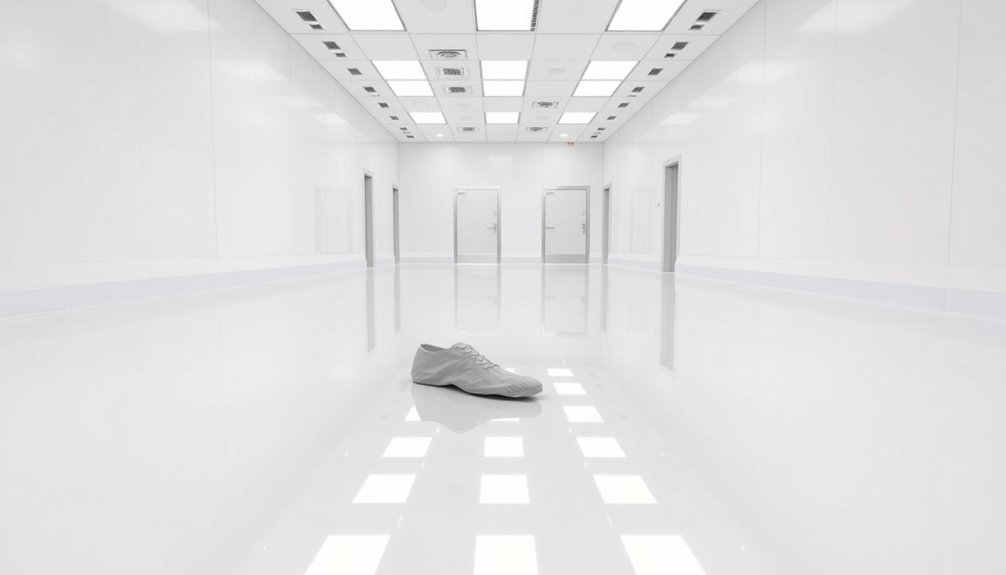



Leave a Reply